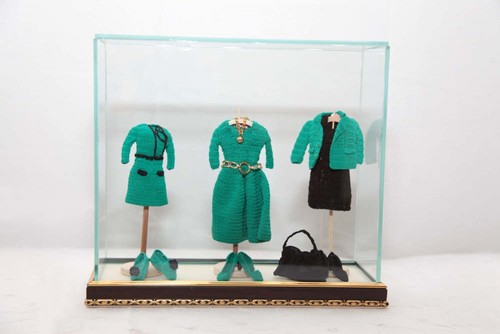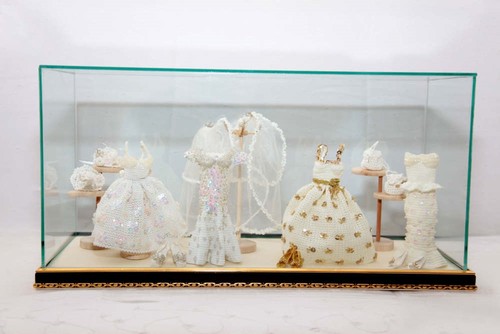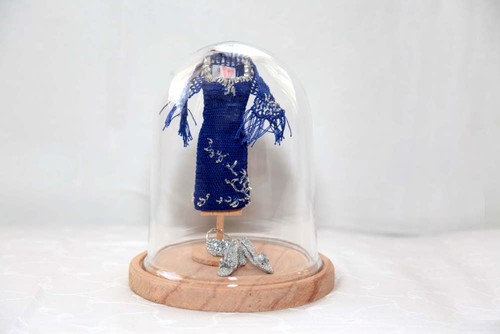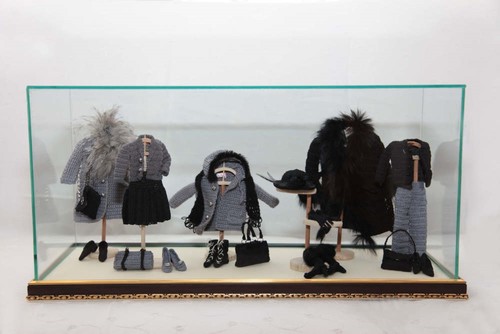© Turkuvaz Haberleşme ve Yayıncılık 2024
Miniature fashion designer Sevda Çelik's new collection of miniature clothes, "Hayallerim Askıda Kalmasın - Zamana Yolculuk" (Fulfilling My Dreams - Time Travel), consists of 192 pieces. Designing nearly 600 miniature dresses to date, Çelik read books on fashion for her latest collection, participated in training at the Istanbul Fashion Academy and conducted research at the library. Additionally, she watched old films while benefiting from the internet and true stories. It took two-and-a-half years to prepare the collection.
She describes her designs as "an interpretation on crochet" in her "miniature boutique" adventure, which she started five years ago. She summarizes her motto as "fulfilling her dreams."

"My miniature boutique project is the embodiment of postponed and built-up dreams which cannot be fulfilled for some reason. I can call it the woman's world, the inner voice and the spirit of art. Many people who see it also say, 'Yes, I should fulfill my dreams.'"
'The dress almos comes alive and talks to me!'
Çelik said she used new techniques for the new collection. "I also tried new practices such as embroidery and needlework on a knitted background, and I did design work. For example, I worked on the 'Waltz in the Palace' dress by applying a honeycomb technique, and I combined the flowers with embroidery. There is a needlework in the folding fan, and the hardest thing was the gloves," Çelik said. She elaborated on her work, adding that she also worked on the countess series, covering until the beginning of the 18th, 19th and 20th centuries and prepared costumes emphasizing the Rococo, Victorian and war periods. "I also worked on the periods in which the concept of fashion began to enter our lives. Those were the times when handcraft, aesthetics and fabric quality were combined and when art was the main determinant in clothing. I also saw in my exhibitions that people who experienced or heard about those periods found much in themselves in my miniature dresses."

Çelik, who divides her collection into two parts - countesses and periods - explains what miniature fashion designs mean for her.
"I don't use models for the clothes. I have kept them abstract so that those seeing it can place their inner women themselves," she continued. "While working on a dress, I think of it as a dress carried by a woman with a life stance. I feel it so much that when the outfit is complete, it comes to life and talks to me!"
Collection features Victorian Era
Çelik also interpreted characters in classical novels and clothes in old movies. Her miniature designs include Anna Karenina, The Lady of the Camellias, and Madame Bovary. "The characters in novels are my own interpretation through a color and model choice. I tried to give spiritual touches to the characters with colors in s ome of my works, for example 'The Lady of the Camellias' is the gown worn by Greta Garbo in Hollywood," Çelik said.

Çelik stressed that the most challenging period for her was the 19th century Victorian Era, adding that she had hard times while getting the bumps on the sides and back in the costume of Victoria. The most challenging and long-lasting outfit, on the other hand, was Marie Antoinette's.
"The flamboyant lifestyle and wasteful attitudes of the Palace of Versailles in France and of the aristocrats was one of the reasons behind the French Revolution. The costume that Marie Antoinette wore during the coronation ceremony had too much fabric. I spent a lot of threads and time. Marie Antoinette is a very fluffy dress. I had difficulty fitting it into the window. There are so many details on the ruffle and accessories," Çelik added.

Having also opened many exhibitions, Çelik said those who see the hand-crafted miniature clothes cannot understand if these clothes are made of fabric or they are knitted. "The reason it can't be understood is because they are worked with very fine threads. They realize that the clothes are knitted as they get closer. When they see the shoes, they cannot believe their eyes. I managed to fix the heels without using any support," Çelik explained, saying that those who see the miniature version of fashion history are bewildered.
